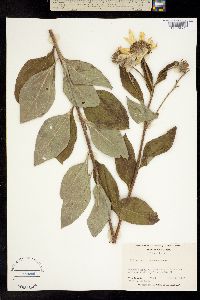Helianthus tuberosus
|
|
|
|
Family: Asteraceae
Jerusalem-Artichoke
[Helianthus tomentosus Michx., moreHelianthus tuberosus var. subcanescens A.Gray] |
Perennials, 50-200+ cm (rhizomatous, producing tubers late in growing season). Stems erect, scabro-hispid to hirsute (sometimes glaucous). Leaves mostly cauline; opposite or alternate proximally, usually alternate distally; petioles 2-8 cm (often ± winged); blades (3-nerved from near bases) lanceolate to ovate, 10-23 × 7-15 cm, bases broadly to narrowly cuneate, margins entire or serrate (flat), abaxial faces puberulent or hirsutulous to tomentulose and gland-dotted (abaxial) or ± scabrous (adaxial). Heads 3-15. Peduncles 1-15 cm. Involucres hemispheric, (10-25 ×) 8-12 mm. Phyllaries (often dark green, drying nearly black) 22-35 (bases appressed, apices ± spreading, sometimes reflexed in fruit), lanceolate, 8.5-15 × 2-4 mm (subequal), (margins ciliate) apices acuminate, abaxial faces hispidulous or puberulent, gland-dotted. Paleae 8-9 mm, 3-toothed (apices hairy). Ray florets 10-20; laminae 25-40 mm. Disc florets 60+; corollas 6-7 mm, lobes yellow; anthers dark brown or black, appendages dark or yellowish. Cypselae 5-7 mm, glabrous or distally hairy; pappi of 2 aristate scales 1.9-3 mm plus 0-1 deltate scales 0.5-0.8 mm. 2n = 102. Flowering late summer-fall. Roadsides, fields, waste areas; 0-1000(-1500) m; Man., N.B., N.S., Ont., P.E.I., Que., Sask.; Ala., Ark., Colo., Conn., Del., D.C., Fla., Ga., Idaho, Ill., Ind., Iowa, Kans., Ky., La., Maine, Md., Mass., Mich., Minn., Miss., Mo., Nebr., N.H., N.J., N.Y., N.C., N.Dak., Ohio, Okla., Pa., R.I., S.C., S.Dak., Tenn., Tex., Utah, Vt., Va., Wash., W.Va., Wis., Wyo.; cultivated and adventive in Europe. Helianthus tuberosus is variable, probably in part stemming from hybridization with other polyploids, including H. pauciflorus, H. resinosus, and H. strumosus. Helianthus tuberosus is so widely spread as a weedy species that its original distribution is difficult to discern. It has been used as a food plant for its tubers by native Americans (although not necessarily domesticated or even cultivated); it has been developed as a crop primarily in Europe, where it has become widely naturalized. The common name Jerusalem artichoke is a misnomer, as explained by C. B. Heiser (1976).
Perennial with well developed, commonly tuber- bearing rhizomes; stems stout, 1-3 m, ±spreading-hairy; lvs numerous, those of the upper half or 2/3 of the stem alternate in well developed plants, scabrous above, short-hairy beneath, broadly lanceolate to broadly ovate, the better developed ones mostly 10-25 נ4-12 cm, serrate, abruptly contracted or somewhat tapering to the winged petiole, this 2-8 cm; heads often many in a corymbiform infl, the disk yellow, 1.5-2.5 cm wide; invol bracts rather dark, especially near the base, narrowly lanceolate, acuminate or subattenuate, loose especially above the middle, often hispidulous; rays 10-20, 2-4 cm; 2n=102. Moist soil and waste places; nearly throughout e. U.S. and adj. Can., and w. across the Great Plains. (H. subcanescens, small plants with chiefly opposite lvs) Gleason, Henry A. & Cronquist, Arthur J. 1991. Manual of vascular plants of northeastern United States and adjacent Canada. lxxv + 910 pp. ©The New York Botanical Garden. All rights reserved. Used by permission. From Flora of Indiana (1940) by Charles C. Deam This is one of our most common sunflowers and is frequent throughout the state. It grows in the open in moist soil along streams, ditches, and roadsides. This species is quite variable and gives more trouble in naming than any other species. Some authors rely upon the tuberous roots for identification. In September, 1936, which was a dry year, I dug in our garden 25 specimens and then went to an old fence row and dug many more and I failed to find a single tuber. I regard the dark color of the bracts and the pubescence on the lower surface of the leaves as the most reliable characters for the identification of this species. The shape and length of the bracts are too variable to consider although in some instances they are quite characteristic and are confirmatory characters. ...... Indiana Coefficient of Conservatism: C = 2 Wetland Indicator Status: FACU Diagnostic Traits: plants to 3 m; stems hairy; leaves opposite, thick, serrate, mostly >3.5 cm wide, pubescent to cinereous beneath; petiole 2-10 cm, winged; phyllaries equalling disk, dark especially near base. |























































































